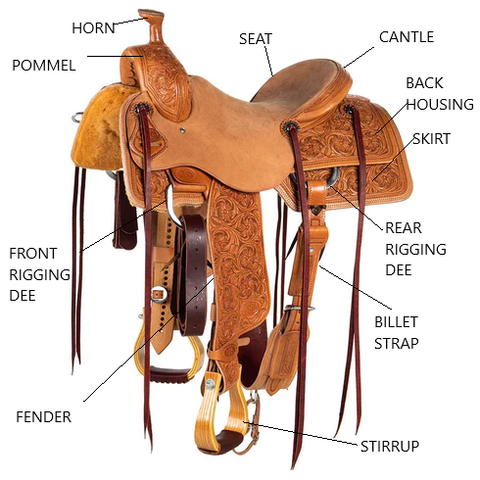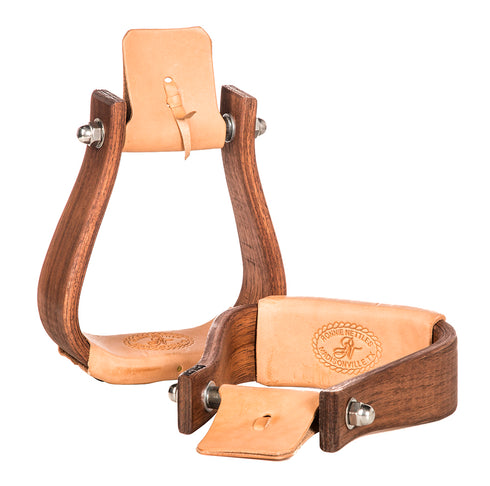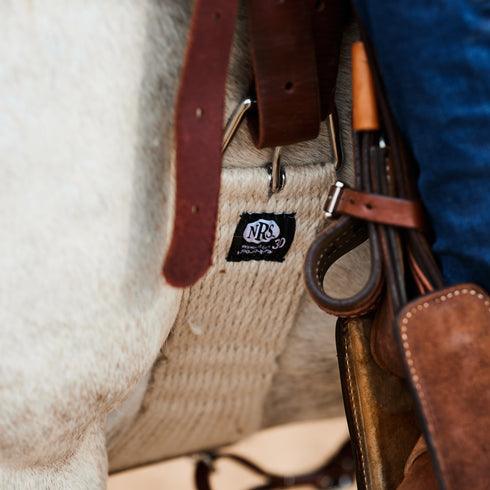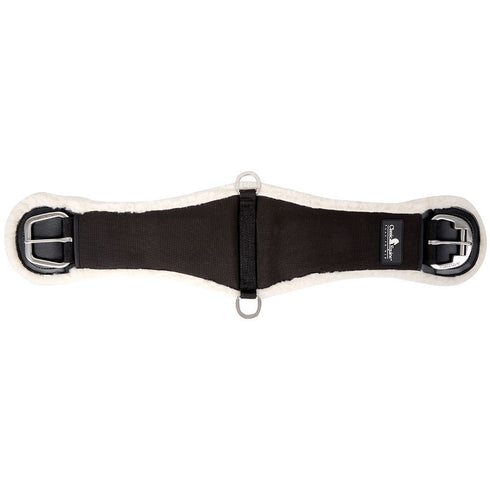
Breaking Down Western Saddle Construction
At NRS World, we're not just slinging saddles; we're saddle experts deeply immersed in the rich tradition of Western saddle making, and we make it our mission to educate and cultivate appreciation for the intricate design and functionality of the Western saddle, a storied emblem of cowboy heritage.
The Western saddle, a quintessential icon of cowboy culture, is designed for comfort and functionality during long hours of ranch work or trail riding. Its design has evolved over centuries, with modern saddles reflecting a blend of both traditional craftsmanship and contemporary innovations. Here, we explore the fundamental elements of a Western saddle, highlighting how each component contributes to its overall utility and comfort.

-
Saddle Tree: A saddle tree is the fundamental framework of a saddle, shaping its form and ensuring proper weight distribution. It's designed to fit both the rider's comfort and the horse's anatomy. Traditionally made from wood, modern saddle trees are often crafted from lighter, durable materials like fiberglass or plastic. The tree consists of two main parts: the bars, which rest on the horse's back, and the fork, which supports the pommel at the front. A well-designed tree evenly distributes the rider's weight, reducing pressure points on the horse, thereby enhancing the comfort and safety of both horse and rider during riding.
-
Seat: The seat of a Western saddle is meticulously designed for long-lasting comfort and security during rides. Shaped to conform to the rider's anatomy, it ensures a snug and stable seating position. The front of the seat, known as the pommel, rises slightly, while the back, called the cantle, is higher to provide support and prevent the rider from sliding backward. The seat's depth and the cantle's height can vary, offering different levels of support and freedom of movement. Quality padding and materials are used to enhance comfort, crucial for long hours spent on horseback in various riding activities.
-
Pommel and Horn: The pommel and horn are distinctive features of Western saddles, each serving specific functions. The pommel, located at the front of the saddle, is a raised area that provides stability and support for the rider. It is especially useful in rugged terrain or during quick movements. Attached to the pommel is the saddle horn, a prominent feature unique to Western saddles. Originally designed for ranch work, such as roping cattle, the horn allows riders to dally a rope securely around it. Today, the horn is not only functional for work but also serves as a stabilizing grip for riders during various equestrian activities.
-
Fenders and Stirrups: Saddle fenders and stirrups are essential components of a horse saddle, playing crucial roles in rider safety and comfort. Fenders are large, flat pieces of leather or synthetic material that hang down from the saddle's seat on either side. They protect the rider's legs from rubbing against the horse, the stirrups, and other parts of the saddle, preventing chafing and discomfort during long rides. Stirrups, attached to the saddle by stirrup leathers or straps, are small platforms where the rider places their feet. They provide stability, balance, and support, helping riders maintain proper posture and control over the horse. Together, fenders and stirrups enhance the riding experience, offering protection and aiding in effective communication between horse and rider.
-
Skirts: Saddle skirts are integral parts of a Western saddle, serving both functional and comfort purposes. These large, flat pieces of leather, attached underneath the saddle's seat, cover the bars of the saddle tree. Skirts help distribute the rider's weight more evenly across the horse's back, reducing pressure points and enhancing comfort for the horse. They also act as a protective barrier, shielding the horse from potential irritation caused by the saddle's hardware and rigging. In addition to their practical role, saddle skirts often feature decorative elements, adding an aesthetic appeal to the saddle's overall design.
-
Rigging: In any Western saddle, the term "rigging" denotes the placement of the dee-rings to which you fasten your latigo and cinch. When we say "in-skirt" rigging, it implies that these dee-rings are integrated into the saddle's skirt. They are sewn between the leather layers, as opposed to a more conventional saddle where the dee-rings are positioned on top of the skirt.
In a traditional Western saddle, you typically encounter three primary styles of rigging: full rigging, seven-eighths, and three-quarter. Understanding each type of rigging and its benefits is crucial for making the most of multiple rigging options.
Full Rigging: Commonly known as "full" saddle rigging, this style places the dee-ring directly beneath the pommel, either on the saddle's tree or skirt. It's the most forward position for riggings. To secure the saddle, the latigo is wrapped from the cinch to this dee-ring, aligning in a vertical line. Saddles with full rigging often include a flank cinch or rear cinch (making it a double rigging) to prevent the saddle from tilting forward on downhill paths or evenly distribute pressure during roping. This double rigging is ideal for ranch riding and roping, balancing the saddle with the pressure concentrated under the pommel and the flank cinch for stability.
7/8 Rigging: This rigging indicates that the cinch is positioned 7/8 of the distance from the cantle to the pommel. It shifts the cinch's pressure slightly rearward on the horse's back compared to the full rigging. A rear cinch can also be used with 7/8 rigging to secure the saddle on slopes, helping the saddle to sit at a balanced point and alleviate pressure on the horse's withers.
3/4 Rigging: This style places the dee-rings slightly behind the 7/8 position, or three-quarters the distance from cantle to pommel. It offers more protection for the shoulders and withers and creates more space between the horse's elbow and the cinch. This rigging is particularly beneficial for horses where the saddle tends to "bridge" on the back, creating pressure at the front and back but not in the middle. The further back the rigging, the more pressure is distributed to the middle of the saddle. The 3/4 rigging moves the cinch away from the horse's heartgirth, which can be helpful in preventing girth sores during extended rides.
-
Cinch: A saddle cinch is an essential component of horse tack, primarily used in Western riding, to secure the saddle firmly on the horse. Essentially, it's a wide strap that wraps around the horse's girth - the area just behind the front legs - and attaches to the saddle's rigging. Cinches are typically made from materials like mohair, neoprene, or a blend of synthetic fabrics, chosen for their strength, flexibility, and comfort for the horse.
The design of a cinch allows for even distribution of pressure, essential for the horse's comfort and safety. It prevents the saddle from shifting during riding, which is crucial in activities like roping, racing, or trail riding. The cinch is fastened using a buckle system, which can be adjusted to achieve the right fit. Proper cinching is vital; too tight can cause discomfort or breathing difficulties for the horse, and too loose can lead to stability issues with the saddle. In addition to the primary cinch, some saddles have a back cinch, also called a flank cinch, for extra stability.
-
Decorative Elements: Who doesn't like a little bling? At NRS World, we understand that style is personal. Our saddles often feature conchos, bespoke tooling, and embossing, allowing riders to express their individuality. These embellishments range from understated to elaborate, reflecting each rider's unique flair.
In summary, the Western saddle is more than just a piece of equipment; it's a testament to the harmony between rider and horse. Our commitment at NRS World is to uphold this legacy through our custom saddles, blending traditional craftsmanship with modern innovation, ensuring every saddle is a tribute to the enduring spirit of the Western equestrian culture.
View Roping Saddles, Barrel Racing Saddles, or NRS Competitor's Series Saddles




